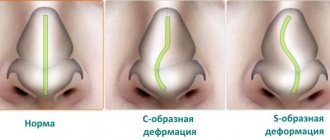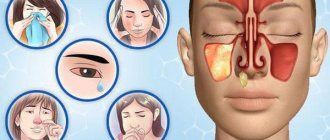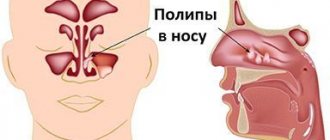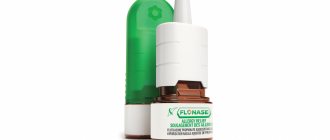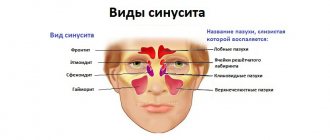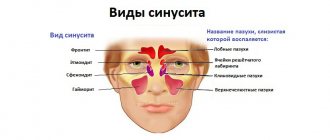Normalization of the nasal mucosa as a medical and social problem
Our body can fully live and develop only if there is a constant exchange of substances between it and its environment. One of the most important forms of communication between the body and the environment, which is not interrupted throughout a person’s life, is communication through the respiratory system. The nose, which is the initial part of the respiratory tract, is a powerful protective barrier that informs the centers about contact with various environmental agents, conditioning the inhaled air, retaining and neutralizing substances that can enter the body with the air [7].
The leading role in the protective function of the nose belongs to the mucous membrane, which is covered with pseudostratified epithelium, consisting of ciliated, goblet, and short and long intercalated epithelial cells. The ciliated cell has numerous cilia at its free end.
| Rice. The structure of the nasal mucosa |
Ciliated cells have 250–300 cilia, 7 microns long and 0.3 microns high. Each cilium consists of 9 pairs of microtubules arranged in a ring and surrounding two unpaired central microtubules. The movement of the cilia of the ciliated epithelium of the nasal mucosa is carried out through the sliding of microtubules. The movement of the cilia is strictly directed - from the vestibule of the nasal cavity towards the nasopharynx. Mucociliary clearance is provided by nasal secretions. The source of the secretion covering the epithelium of the nasal cavity is the mucous glands of the nasal mucosa, goblet cells, extravasation from subepithelial capillaries, lacrimal glands, and the secretion of specialized Bowman glands from the olfactory zone of the nose [7] (Fig.).
The volume of nasal secretion in 24 hours ranges from 100 ml to 1–2 liters. The mucous membrane of the posterior two-thirds of the nasal cavity is renewed every 10–15 minutes. The function of the cilia is optimal at a temperature of 28–33 °C, a sufficient amount of secretion with a pH of 5.5–6.5. Loss of moisture, a decrease in temperature to 7–10 °C, and an increase in secretion pH above 6.5 cause the cilia to stop vibrating [8, 11].
The mucous membrane of the nasal cavity is the first barrier to the protection of the respiratory tract, therefore thousands of microorganisms are deposited on the mucous membrane of the nasal cavity every second. Most of them are representatives of saprophytic microflora and do not cause any harm to humans, while others can provoke the development of an infectious disease. With infectious rhinitis, the proliferation of microbes on the nasal mucosa leads to its damage and peeling of the upper part of the epithelium. This process explains all manifestations of a runny nose: a burning sensation in the nose, discharge of mucus (exudate), nasal congestion, changes in voice (nasality), etc. [9].
Rhinitis is rarely an independent disease. Most often, a runny nose is a symptom of some other nosological form. A runny nose is observed with various acute respiratory viral infections or acute respiratory infections (influenza, parainfluenza, adenoviral infection, measles, etc.). Acute respiratory diseases are the most common in the structure of infectious diseases. In Russia, about 50 million cases of infectious diseases are registered annually, of which up to 90% of cases are acute respiratory viral infections. In the case of pathology of the ENT organs, the mucous membrane with its glandular cells is primarily affected.
In addition to infectious diseases, in industrialized countries currently 10% to 20% of the population suffers from acute allergic diseases. In addition, in the pathogenesis of inflammatory diseases of the upper respiratory tract, along with local and general exposure to the pathogen, sensitization of the body and immunological changes directly in the mucous membrane of the nose and paranasal sinuses play a role [4].
The nasal mucosa is the area that is exposed to a wide variety of foreign particles. Allergen molecules extremely quickly cause an allergic reaction, as a result of which sneezing, itching in the nasal cavity, and rhinorrhea occur within a minute after the penetration of allergens [5, 6].
Other etiological factors for damage to the mucous membrane may include unfavorable ecology, occupational hazards, and bad habits (tobacco smoking, drug addiction). In the city, directly below the surface of the earth, the highest concentration of all types of xenobiotics is found - free radical compounds, carcinogens, heavy metal salts, all types of allergens, and, of course, pathogenic microorganisms. The mucous membrane of the nose, mouth and pharynx is in constant contact with inhaled air and is thus exposed to harmful environmental factors, which leads to its swelling. In any case, conditions arise in which the nasal mucosa becomes easily infected, reacting with the appearance of significant swelling [3].
As a side effect, medications taken for various diseases often cause subatrophy of the nasal mucosa due to systemic action, which is especially important for representatives of holospeech professions due to the upcoming changes in the resonator tract [1, 10].
In some diseases, for example, diabetes, atrophic and subatrophic rhinitis often develop due to disturbances in the microcirculatory system. Taking into account the prevalence of this disease, in particular, due to the decreasing age of those who first become ill (the working population), problems with moistening the nasal mucosa are of a social nature.
As studies show, the planet's population is aging, average life expectancy is increasing and, accordingly, the requirements for quality of life in this population group are increasing. It is known that with a decrease in the level of sex hormones caused by menopause in women and a decrease in the function of the gonads in men, the likelihood of developing subatrophic and atrophic processes on the skin and mucous membranes increases sharply.
Thus, in normalizing the function of the nasal mucosa, the leading directions of therapy are:
1) stimulation of local and general blood circulation, i.e. increased supply of the mucous membrane with nutrients; 2) moisturizing the nasal mucosa and preventing the formation of crusts; 3) fight against local pathological microflora.
Topical preparations containing essential microelements that regulate the rheological properties of mucus meet these principles. It is believed that trace elements contained in an isotonic solution, such as Ca, Fe, K, Mg, Cu, help to increase the motor activity of cilia, activate reparative processes in the cells of the nasal mucosa and normalize the function of its glands [7]. The listed microelements are contained in preparations that are prepared from sea water, sterilizing it and bringing the salt content to isotonic concentration, and from mineral spring water, which has medicinal properties.
It is known that sea water is very beneficial for the human body, as it contains many valuable micro- and macroelements. Sea water activates all vital processes of the body, increases its resistance to various diseases, and has a local antiseptic effect.
Healing properties of sea water:
- Rinsing the nasal cavity with sea water has an antibacterial effect, washing away dust, viruses and bacteria.
- Gargling with warm sea water treats throat diseases and restores the vocal cords.
- Sea baths and air stimulate the endocrine system.
- Sea water accelerates the healing of abrasions and cuts due to the content of large amounts of salts and trace elements.
- Rinsing your mouth with warm sea water strengthens your teeth and gums.
One of the new drugs in this group is Otrivin More [2], which is a purified, decontaminated isotonic solution of ocean water from Brittany, obtained in an ecologically clean area of the Atlantic Ocean, rich in natural microelements. It contains 18 minerals and trace elements.
Thanks to this composition, Otrivin More is ideal for protecting the nasal mucosa from unfavorable city conditions, as well as for facilitating nasal breathing during illness. Otrivin More ensures rapid elimination of pathogens and allergens, that is, it significantly reduces their concentration and promotes mechanical cleansing of the surface of the nasal mucosa. In addition, Otrivin More stimulates ciliated epithelial cells, helps normalize mucus production and dilute it, and also increases local immunity. An important advantage of the drug is the absence of any systemic effect on the patient’s body, which is extremely important for people suffering from various somatic diseases and who are afraid of taking traditional topical vasoconstrictors due to the risk of side effects. In addition, the patient has the opportunity to reduce the dosage of other medications used for complex treatment and speed up recovery.
Otrivin Sea can be used both for preventive and therapeutic purposes, and for daily hygiene of the nasal cavity. The new product does not contain preservatives or additional chemical ingredients. The main indications for prescribing the drug are acute rhinitis (including allergic) and nasal congestion. For a runny nose and allergies, Otrivin Sea makes breathing easier, gently cleansing the nasal passages, and also has an antiseptic effect. In addition, the product can be used for nasal hygiene before using other medications. For prevention purposes, it is possible to use the drug Otrivin More during epidemics of various viral diseases, which prevents the development of various forms of infectious process on the nasal mucosa. The drug can also be used for the purpose of hygiene of the nasal cavity, effectively cleansing the nasal mucosa and gently moisturizing it. The natural composition of Otrivin More will not only ensure the high safety of the treatment, but also allows you to use the drug for rinsing the nose for allergies.
Many nasal sprays cause discomfort when taking them, which is associated with irritation of the nasal mucosa. Otrivin More in the form of a nasal douche is free of this side effect. By carefully rinsing the nasal cavity, the drug removes dust, bacteria and secretions and prevents it from drying out, thereby protecting it from the irritating effects of external factors, which is especially important for people working in rooms with excessively dry air (for example, where air conditioners are installed or near heating devices ).
The form of release of the drug is of great importance. When using nasal drops, most of the injected solution flows down the bottom of the nasal cavity into the pharynx. In this case, the required therapeutic effect is not achieved. In this regard, the prescription of metered aerosols looks much more profitable, for example, a feature of the drug Otrivin More is that it is released in the form of a nasal spray.
Otrivin Sea can also be used for daily nasal hygiene. This procedure has been known since ancient times and is no less important for our health than brushing our teeth. In the modern world, in cramped and dusty cities, daily preventive rinsing of the nose with sea water has become especially important.
For the convenience of patients, Otrivin More is available in bottles of optimal volume - 50 and 100 ml, which will be appropriate in both home and travel first aid kits. In addition, the Otrivin More bottle is equipped with a universal nozzle, suitable for the whole family and can be recommended for children from the age of three months. At the same time, the spray tip will ensure accurate and uniform moistening of the nasal cavity, and a special valve that protects the medicine from microorganisms entering it guarantees a long period of use after the first use.
Thus, the drug Otrivin More is a reliable remedy that cleanses the nasal mucosa in adults and children, restoring its physiological function, without causing dryness and having a persistent long-term effect, thereby preventing the development of serious complications and at the same time carefully affecting its structural components . Otrivin More can be used both for the treatment and prevention of a runny nose, as well as to protect the nasal mucosa from irritating environmental influences.
Literature
- Voloshina I. A., Turovsky A. B. Irrigation therapy of atrophic rhinitis. S. 1906.
- State register of medicines. M.: Ministry of Health of the Russian Federation, 2008.
- Gurov A. A. Swelling of the mucous membrane of the upper respiratory tract. How to deal with it? 1254 pp.
- Karpova E. P., Usenya L. I. Topical decongestants for the treatment of inflammatory diseases of the nasal cavity and paranasal sinuses in children. P. 18.
- Markov G.I. Transport function of the ciliated epithelium of the nasal mucosa in inflammatory diseases // Bulletin of Otorhinolaryngology. 1985. No. 4. pp. 36–37.
- Palchun V. T., Magomedov M. M., Luchikhin L. A. Otorhinolaryngology. M.: Medicine. 2002. 576 p.
- Piskunov G.Z., Piskunov S.Z. Clinical rhinology. M., 2002. 390 p.
- Pluzhnikov M. S., Shanturov A. G., Lavrenova G. V., Nosulya E. V. Nasal mucosa. Mechanisms of homeostasis and homokinesis. St. Petersburg 1995. pp. 5–18.
- Ryazantsev S.V. Modern decongestants in the complex therapy of acute and chronic diseases of the ENT organs // Russian Otorhinolaryngology. 2008, No. 6 (19).
- Deitmer T., Scheffler R. The effect of different preparations of nasal decongestans in ciliary beat frequency in vitro // Rhinology. 1993; 31–151–3 (14).
- Satir P. How cillia move // Scientific American. 1974. Vol. 231. P. 45–46.
N. E. Boykova, Candidate of Medical Sciences
Scientific and Clinical Center of Otorhinolaryngology of the Federal Medical and Biological Agency, Moscow
Contact information for authors for correspondence
Everyone knows how important breathing is for maintaining the vital functions of the body. But few people think about how even a slight disruption of normal nasal breathing can affect the condition of various human organ systems.
Various anomalies of the upper respiratory tract, diseases not detected in a timely manner and not treated (adenoids, sinusitis, rhinitis, deviated nasal septum, etc.), as well as a number of other reasons, can lead to the development of pathological changes in the nasal mucosa that are difficult to eliminate or cannot be eliminated at all, to disruption of normal nasal breathing, which subsequently contributes to the occurrence of diseases of various body systems.
Due to difficulty in nasal breathing, a “transition” to breathing through the mouth occurs. Such people usually sleep with their mouths open, their sleep is restless, intermittent and often accompanied by snoring. No matter how long they sleep, patients with impaired nasal breathing constantly complain that they do not get enough sleep, so they usually look lethargic and apathetic. For this reason, schoolchildren and students often experience a decrease in academic performance, weakening memory and attention; adults experience a decrease in performance and become irritable.
In the nose, the inhaled air is purified, moistened, and warmed. When breathing through the mouth, unpurified (this is in our environmental situation!!!), dry and cold air enters the lungs, which inevitably entails diseases of the lungs and bronchi.
Such patients often complain of headaches, as a result of obstructed outflow of blood and lymph from the brain; this condition is explained by congestion in the nasal cavity.
The most dangerous thing is “improper breathing” for a growing organism. Constant breathing through the mouth leads to deformation of the facial skeleton. Such children often develop malocclusion. As a result of prolonged difficult nasal breathing, the chest is deformed. Ventilation of the lungs is disrupted, blood oxygen saturation decreases, the number of red blood cells and hemoglobin content decreases.
When breathing through the mouth, there is less resistance to air flow, as a result of which the development of positive and negative pressure in the chest cavity, necessary for the normal functioning of the heart, is suppressed.
Thus, impaired nasal breathing affects not only the respiratory organs directly, but can also lead to significant pathological changes throughout the body. When a person switches to breathing through the mouth, the entire functioning mechanism of various organs and systems is disrupted. The respiratory rhythm, blood flow and nutrition of the brain are disrupted, and as a result - deterioration of memory, thinking abilities, disruption of blood composition, functions of the cardiovascular system...
